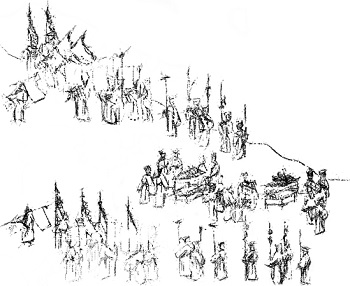Names and DOB
- Childhood name: Shutarūgani 小樽兼
- Chinese-style name: Ju Tatsuro 壽達魯
- Born: as the firstborn son, 1494
Family
- Father: Shinpuku 眞福
- Mother: Taira Ōamushirare 平良大阿母志良禮
- Wife: a person from Izumisaki village 泉崎村 (died 1578-09-10. Posthumous name: Shūkei 秋桂)
- Oldest son: Shinmei 眞命
- Second son: Gima Chikudun Pēchin 儀間筑登之親雲上
- Oldest daughter: Manabi 眞鍋 (date of birth unknown. Married Sanabe Uēkata Kōjō 佐邊親方厚上 of the Fu-clan 傅氏. Died 1603-12-07. Posthumous name: Dōsen 道泉)
- Second daughter: Umitu 思戸 (date of birth and death unknown, married Oroku Pēchin Seiyō 小祿親雲上清乘 of the Hyō-clan 馮氏)
Chronology
During the Era of King Shō Shin 尚眞王
- 1523-08-26: At the time when chief-envoy Tei Jō 鄭縄 and vice-envoy Kin Ryō 金良 proceeded to China to bring tribute, he served as a of the royal treasure ship (takara-maru 寳丸) and reached Fujian
During the Era of King Shō Sei 尚清王
- 1536-05-13: Appointed Jitō (estate steward) of Ameku in Nishihara district 西原間切天久地頭
- 1537-08-09: Conferred to the court rank of Zashiki (rank 4 minor) 座敷
- 1537-08-20: At the time when chief-envoy Chin Fu 陳賦 and vice-envoy Sai Teibi 蔡廷美proceeded to China to bring tribute, he served as an emissary (shisha 使者) of the royal ship Yotsuzutomi世續富 and reached Fujian
- 1541-09-07: Served as emissary (shisha 使者) for bringing tribute to China, together with vice-envoy Sai Teibi 蔡廷美 they reached Fujian
- 1545-11-06: transferred and appointed Jitō (estate steward) of Kanagusuku in Gima, Mawashi district 眞和志儀間金城地頭
- 1551-04-13: Transferred and appointed Jitō (estate steward) of Gima in Mawashi district 眞和志儀間地頭
- 1552-06: When the construction of the dike fort Yarazamori 牙浪沙森 (=屋良座森城) in Naha harbor was completed, a monument was erected with an inscription describing the ancient military organization of Ryūkyū and mentioning Gima Pēchin Shinmō as a military commander (Seitō). Two years later in 1554, the Ryūkyūan troops received marching orders, with three regiments gathered at their designated places, and repelled attacking pirates. While there is no document to proof so, it may be assumed that Gima Pēchin Shinmō took part in this mission as a military commander, too.
- 1577-04-16: He died after a long life of 84 years. Posthumous name: Gekka 月花
Additional Info

The Hiki of old Ryukyu were an organic combination of various government functions: military , overseas trade, ceremony, politics, and religion.
I have described the formation and organization of the ancient military organization of Ryūkyū in detail in my book Karate 1.0, including important parts of the text of the Yarazamori monument. This description is valuable and indispensable to understand the circumstances in which ancient martial arts of Ryūkyū were implemented.
As Takara Kurayoshi put it, “the Hiki were networks into which the Ryūkyūan upper classes were incorporated for the purposes of military, police, and guard service and other duties.”
Here follows one part of the Yarazamori inscription, first translated in a Western language in my book Karate 1.0 (2013), and here for the first time online:
“On occasion of Chinese envoys delivering the imperial decree of investiture for King Shō Sei in 1534, the armored Seitō and Chikudun regiments (hiki) arrived with their military equipment, and the soldiers (Kerai akukabe) all gathered at Miegusuku fortress. Serving the Council of State, the Chikusaji regiment commanders with their commoners from Tomigusuku and Oroku districts all gathered at Yarazamori fortress. Serving the Council of State, the Jitō (Estate Steward) of Gima set out controlling the watercourse to the left and right of the harbor with two small boats, and welcomed the Chinese envoys. And at the time of the Imperial investiture, Gima wore imperial clothes and imperial cap and attendants covered him with a long-handled parasol, to welcome the Chinese Imperial ships outside the harbor.”
Seitō, Chikudun, Kerai akukabe, and Chikusaji are some of the important designations of warriors of old Ryūkyū.
Sources
- 沖縄の歴史情報 第5巻。画像と全文テキストデータベース (Ⅰ)。 (6)「琉球家譜」の情報化。①首里系家譜。麻姓家譜 (田名家).
- Naha-shi Shi. Shiryō-hen, Dai Ni Maki, Chū no 7. Naha no Minzoku. 那覇市史。資料篇 第2巻,中の7。那覇の民俗。
- Takara Kurayoshi: King and Priestess. Spiritual and Political Power in Ancient Ryukyu. In: The Ryukyuanist. The International Society for Ryukyuan Studies. Newsletter No. 27. Winter 1994-95: 3.
- Quast, Andreas: Karate 1.0. Düsseldorf, 2013.
- Others.
© 2016 – 2022, Andreas Quast. All rights reserved.
